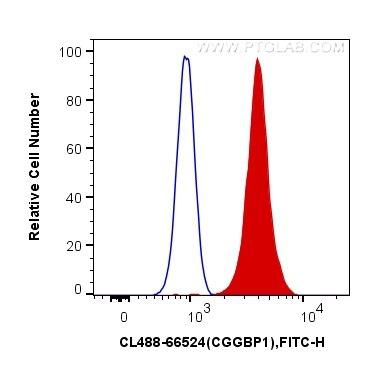CGGBP1 Monoklonaler Antikörper
CGGBP1 Monoklonal Antikörper für FC (Intra)
Wirt / Isotyp
Maus / IgG1
Getestete Reaktivität
human, Maus, Ratte
Anwendung
FC (Intra)
Konjugation
CoraLite® Plus 488 Fluorescent Dye
CloneNo.
2F5G9
Kat-Nr. : CL488-66524
Synonyme
Geprüfte Anwendungen
| Erfolgreiche Detektion in FC (Intra) | HeLa-Zellen |
| Erfolgreiche Detektion in FC | HeLa-Zellen |
Empfohlene Verdünnung
| Anwendung | Verdünnung |
|---|---|
| Durchflusszytometrie (FC) (INTRA) | FC (INTRA) : 0.40 ug per 10^6 cells in a 100 µl suspension |
| Durchflusszytometrie (FC) | FC : 0.40 ug per 10^6 cells in a 100 µl suspension |
| It is recommended that this reagent should be titrated in each testing system to obtain optimal results. | |
| Sample-dependent, check data in validation data gallery | |
Produktinformation
CL488-66524 bindet in FC (Intra) CGGBP1 und zeigt Reaktivität mit human, Maus, Ratten
| Getestete Reaktivität | human, Maus, Ratte |
| Wirt / Isotyp | Maus / IgG1 |
| Klonalität | Monoklonal |
| Typ | Antikörper |
| Immunogen | CGGBP1 fusion protein Ag1129 |
| Vollständiger Name | CGG triplet repeat binding protein 1 |
| Berechnetes Molekulargewicht | 19 kDa |
| Beobachtetes Molekulargewicht | 19 kDa |
| GenBank-Zugangsnummer | BC005222 |
| Gene symbol | CGGBP1 |
| Gene ID (NCBI) | 8545 |
| Konjugation | CoraLite® Plus 488 Fluorescent Dye |
| Excitation/Emission maxima wavelengths | 493 nm / 522 nm |
| Form | Liquid |
| Reinigungsmethode | Protein-G-Reinigung |
| Lagerungspuffer | PBS with 50% glycerol, 0.05% Proclin300, 0.5% BSA |
| Lagerungsbedingungen | Bei -20°C lagern. Vor Licht schützen. Nach dem Versand ein Jahr stabil. Aliquotieren ist bei -20oC Lagerung nicht notwendig. 20ul Größen enthalten 0,1% BSA. |
Hintergrundinformationen
CGGBP1, also named as CGGBP, is a 20 kDa CGG-binding protein. It binds to nonmethylated 5'-d(CGG)(n)-3' trinucleotide repeats in the FMR1 promoter. CGGBP1 may play a role in regulating FMR1 promoter. It is a bona fide midbody protein required for normal abscission and mitosis in general.(PMID:20832400)
Protokolle
| PRODUKTSPEZIFISCHE PROTOKOLLE | |
|---|---|
| FC protocol for CL Plus 488 CGGBP1 antibody CL488-66524 | Download protocol |
| STANDARD-PROTOKOLLE | |
|---|---|
| Klicken Sie hier, um unsere Standardprotokolle anzuzeigen |


